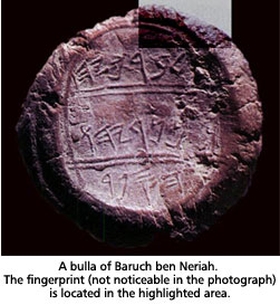Jeremiah Chapter 36
36:1 In the fourth year of Jehoiakim the son of Josiah, king of Judah — This would have been around 605 BCE, one year after Nebuchadnezzar’s defeat of Pharaoh Neco II at Carchemish. The power had shifted from Egypt to Babylon. In the next year (the year the scroll in this chapter was read to Jehoiakim), Nebuchadnezzar subdued all of the surrounding regions and demand tribute. The only city to refuse was Ashkelon, which was then completely destroyed by the Babylonian armies.
36.2 Take a scroll and write on it all the words that I have spoken to you — In this chapter we find one of three instances in the scripture where there is a direct reference to someone writing prophetic, revelatory words from God (the other two examples are Moses’s re-writing on new tablets of the initial words of the covenant that were broken and John’s instruction to write in the Book of Revelation). In this instance concerning Jeremiah, we get insight into several things:
First, the writing of Jeremiah’s revelation is communal. It doesn’t just take place with Jeremiah alone. YHWH reveals the message to Jeremiah and Jeremiah dictates to Baruch the scribe.
Second, the process took time. The revelation began in the fourth year of Jehoiakim but was not shared by Baruch until the fifth year and ninth month. So, while we don’t know exactly how long it took to write the message, it did take at least ninth months and probably more for the message to reach those for whom it was intended.
Third, the process of writing the revelation allowed for re-writing and revision. The original message was destroyed when the manuscripts were burned by Jehoiakim, but Jeremiah dictated again to Baruch and, interestingly, the scripture says ‘…and still were added upon them many words like them.” This means that there were, in some sense, two original manuscripts of YHWH’s revelation to Jeremiah, and they were different from one another in terms of content.
36:3 that I may forgive their iniquity and their sin — YHWH’s goal is not the annihilation of Judah and Israel, but YHWH seeks their repentance (Hebrew shuv, “turn around”/”return”) so they can be forgiven.
36:4 Baruch the son of Neriah — Baruch the scribe would have been highly educated and must have had connection with either the royal house or the priests, or both. His access to the inner workings of the kingdom and the temple would indicate this. There are two clay seals that appeared on the antiquities market with the following in paleo-Hebrew:
1 lbrkyhw – [belonging] to Berachyahu
2 bn nryhw – son of Neriyahu
3 hspr – the scribe
Unfortunately, since they were not found in a recorded archeological dig, their provenance cannot be proven and there is much debate about their authenticity. Here is an image of one of the seals, which emerged on the antiquities market in 1996. This seal has a fingerprint on the edge of one side:

36:23 columns of the scroll — Ancient texts written on papyrus or skins are typically written in columns across the writing surface and then rolled into a scroll. These columns were usually about the width of a thigh, as it is seems scribes may have used their thighs as writing surfaces. Though written much later (400 years), a good example of a columned text is the great Isaiah scroll found among the Dead Sea Scrolls at Qumran. Hand-written Torah scrolls are the same.

The Great Isaiah Scroll, Photographs by Ardon Bar Hama, author of original document is unknown. – Website of The Israel Museum, Jerusalem. Photo from wikipedia public domain
36:23 until the entire scroll was consumed in the fire — The scrolls were likely written on papyrus, making them easy to cut and the stench of the burning would not have been bad as burning leather. The act of burning may have been a ritualistic attempt to destroy the words contained in the scrolls. In the Ancient Near East, written words of prophecy were sometimes seen as carrying a level of supernatural power and authority, with the power to create reality. Burning these words may have been an attempt to actually destroy them and their effect.
36:30 his dead body shall be cast out — Being left unburied was seen as a curse. In many Ancient Near Eastern cultures, such a fate would mean that the person left unburied would find no rest in death.
36:31 but they would not hear — This seems to be the pattern of human beings continually, from the beginning to the end of the scriptures. God reaches out to us, speaks to us, and we do not hear.
36:32 Jeremiah took another scroll and gave it to Baruch the scribe — This was covered in the commentary on 36:2 above.